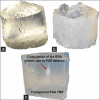High-quality Agar and Polyacrylamide Tumor-mimicking Phantom Models for Magnetic Resonance-guided Focused Ultrasound Applications
- PMID: 38882616
- PMCID: PMC11175378
- DOI: 10.4103/jmu.jmu_68_23
High-quality Agar and Polyacrylamide Tumor-mimicking Phantom Models for Magnetic Resonance-guided Focused Ultrasound Applications
Abstract
Background: Tissue-mimicking phantoms (TMPs) have been used extensively in clinical and nonclinical settings to simulate the thermal effects of focus ultrasound (FUS) technology in real tissue or organs. With recent technological developments in the FUS technology and its monitoring/guided techniques such as ultrasound-guided FUS and magnetic resonance-guided FUS (MRgFUS) the need for TMPs are more important than ever to ensure the safety of the patients before being treated with FUS for a variety of diseases (e.g., cancer or neurological). The purpose of this study was to prepare a tumor-mimicking phantom (TUMP) model that can simulate competently a tumor that is surrounded by healthy tissue.
Methods: The TUMP models were prepared using polyacrylamide (PAA) and agar solutions enriched with MR contrast agents (silicon dioxide and glycerol), and the thermosensitive component bovine serum albumin (BSA) that can alter its physical properties once thermal change is detected, therefore offering real-time visualization of the applied FUS ablation in the TUMPs models. To establish if these TUMPs are good candidates to be used in thermoablation, their thermal properties were characterized with a custom-made FUS system in the laboratory and a magnetic resonance imaging (MRI) setup with MR-thermometry. The BSA protein's coagulation temperature was adjusted at 55°C by setting the pH of the PAA solution to 4.5, therefore simulating the necrosis temperature of the tissue.
Results: The experiments carried out showed that the TUMP models prepared by PAA can change color from transparent to cream-white due to the BSA protein coagulation caused by the thermal stress applied. The TUMP models offered a good MRI contrast between the TMPs and the TUMPs including real-time visualization of the ablation area due to the BSA protein coagulation. Furthermore, the T2-weighted MR images obtained showed a significant change in T2 when the BSA protein is thermally coagulated. MR thermometry maps demonstrated that the suggested TUMP models may successfully imitate a tumor that is present in soft tissue.
Conclusion: The TUMP models developed in this study have numerous uses in the testing and calibration of FUS equipment including the simulation and validation of thermal therapy treatment plans with FUS or MRgFUS in oncology applications.
Keywords: Agar; focus ultrasound; magnetic resonance imaging; phantom; polyacrylamide; tumor.
Copyright: © 2023 Journal of Medical Ultrasound.
Conflict of interest statement
The authors declare that they have no known competing financial interests or personal relationships that could have appeared to influence the work reported in this paper.
Figures










References
-
- Rhim H, Dodd GD., 3rd Radiofrequency thermal ablation of liver tumors. J Clin Ultrasound. 1999;27:221–9. - PubMed
-
- Zhao Z, Wu F. Minimally-invasive thermal ablation of early-stage breast cancer: A systemic review. Eur J Surg Oncol. 2010;36:1149–55. - PubMed
-
- Furusawa H, Namba K, Thomsen S, Akiyama F, Bendet A, Tanaka C, et al. Magnetic resonance-guided focused ultrasound surgery of breast cancer: Reliability and effectiveness. J Am Coll Surg. 2006;203:54–63. - PubMed
LinkOut - more resources
Full Text Sources
